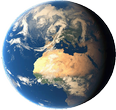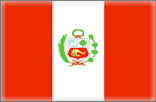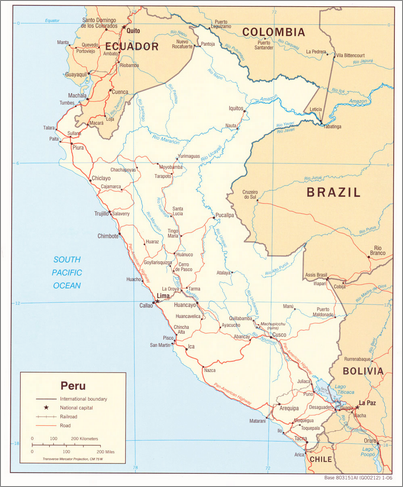




| Lima is the biggest and at the same time in our opion the least attractive cities of Peru. Because Lima is always covered in mists floating in from the pacific, there's hardly any direct sunlight which makes the city become very dull greyish. The old city center is nice which some nice colonial buildings including an impressive cathedral, but except for the more modern and safer neighboorhood of Miraflores there's no need to stay longer in Lima than necessary. Lima is a very poor city which becomes very evident when you reach its outskirts where the slumps are located: Just small huts with no electricity or water situated against big sand dunes. |

| The Colca Canyon is the second deepest canyon in the world and is totally worth a visit (from Arequipa). We did a 3 day trekking down to the valleyfloor. You'll come across some wonderful scenery and there are some simple huts managed by locals where you can spend the night. One of the highlights of the canyon is a visit to the Cruz del condor. When you arrive there eraly in the morning you'll be guaranteed to see Andes condors flying overhead at very close range. Unfortunately this site is very touristy and that is a major drawback, but, when you stay a bit longer than the 2 hours that most tourist stop here, you'll have the spot for yourself. After the trekking we visited the hotsprings of Chivay, to relax and get rid of the dirt. |
| A couple of hours south of Lima there are a group of islands (Islas Ballestas, 'Arch Islands') just off the coast. They are a must for every nature lover, since it harbours one of the biggest bird colonies in the world. From the coast you can make boat excursions to the Islands, which are really overcrowded with thousands of brown boobies, pelicans, cormorants, Inca Terns and Humboldt Penguins. The islands are covered in white guano (bird dung), which not so long a go was the major export product of Peru as agricultural fertilizer. In addition, you are very likely to spot sea lions and dolphins. South of the Islands is a national Park that protects a spectacular coastline. Here one of the driest deserts in the world and the pacific ocean lie side by side. There are very steep cliffs with fantastic views. |

| Arequipa is a very pretty city at 2700m altitude. Its center is built around a nice rectangular square, which is lined by colonial buildings with big balconies, and has a nice backdrop of 6km high Andes mountains. The city itself has some attractions including a museum dedicated to 'huanita', a mummified girl that had been sacrified on the summitof a 6000m mountain by the Inca's. Very intruiging. There is also a big still used monestary, which is for most part open for tourists. |

| The Nasca Lines still remain one big mystery: Who made them, what was their function, how old are they? Irrespective of these questions these figures are of an extraordinary beauty. Lines carved in the desert forming geometrical figures or even animals. Most are are around a hundred meters big and are spread across a couple of sqaure kilometres. As consequence the only way to fully appreciate them is by flying over them. With a small plane you can fly in half an hour over most of the figures. Except for these Nasca lines there's not much to do in Nasca. |

| In the middle of the desert close to Ica is this small oasis. A small lake surrounded by palm trees and a couple of hostels and restaurants that's all there is. The main activity why people come here is sandboarding. And indeed the enormous sand dunes all around are very inviting. The rest of the day you can chill by the pool. Watching the sunset from one of the dunes is fantastic. |

| Lago Titicaca is supposed to be the highest navigatible lake in the world. Whether this is true, I don't know, but it is truly a remarkable place at 3800m altitude. The deep blue skies and the harsh sun light give the lake a beautiful dark blue color. We visited the Uros Indians, who have made flaoting reed-islands their home. On these islands they have their reed-houses, and even a primary school. Furthermore, we spent a night on Isla Amantani in a house of friendly local family. Unfortunately, communication was difficult because they only spoke Aymara. The people on the island nearby, which we also visited, have a different origin with other customs: man wear hats from which you can tell whether they are married or not and below or above 18 years of age. |
© Bart Everts

 |
 |
 |
 |
 |


| Manu National Park protects a hugh span of virgin cloud and lowland rainforest in Eastern Peru. Because its national Park status was established before serious logging or hunting could damage the forest and its inhabitants, it is one of the biologically richest protected areas within the Amazon basinm both in quality and quantity. For instance more than a 1000 different bird species have been described to live this park! During a 9-day trip into this magnificant park, we stayed in several simple lodges, from where we made some nice walks into the forest or baot trips over the rivers. We saw lots of animals including 7 species of monkey, peccaries, Tamandua, Giant otters and capibaras. Especially a visit to a clay lick was a colorful spectacle: Hundreds of parrots and macaws come together to eat minirals that neutralize toxins from fruits they eat. Although it was quite expensive, it was worth every penny and you just have to see it for yourself: This is what virgin rainforest should look like. We highly recommend Pantiacolla as tour operator for Manu. |

| Cuzco was the 'belly button' of the Inca Empire 500 years ago. Although from the outside most buildings in Cuzco are from Spanish origin, the backbone is mostly from Inca origin. With many hostels, hotels, restaurants, bars, museums, Inca Ruins in and around the city (especially in the sacred valley and of course Macchu Piccu), Cuzco has it all. Not surprisingly, this attracts many tourists, but luckily Cuzco is big enough that it doesn't become too annoying. In Cuzco itself there's more than enough to see and do to spend a couple of days, before you head of to Macchu Piccu or the rainforest. |

| Macchu Piccu is the single most important archeological site and the biggest tourist draw of South America. Its fantastic location and still unresolved function during Inca times, make a visit to this place a extraordinary and mystical experience. Although you can visit the site from Cuzco by train, we highly recommend to reach it on foot via an Inca Trail. We did it on the the 4 day classical trail. Nowadays, the number of tourist allowed on this trail is restricted to 500 a day, and as a result you have to book at least 3 months in advance to get a permit for this trekking. It is a fantastic experience: While porters carry your tent and food, you'll come across several ruins, high altitude crossings, and elphin and cloud forests. Finally, you end up at the sungate the very last morning before sunrise from where you can fully appreciate Macchu Piccu being enlightened by the very first rays of sunlight of a new day. Without any special training, but just in good health, you'll be able to finish the Inca trail without problems. (we went with the very recommendable trekkingcompany 'Perutreks') |

 |
 |
 |
 |
 |
 |
 |
 |
 |
 |










 |
| Physical activities: eg Walking / Rafting / swimming Nature: eg National Park / Reserve City / Cultural site |
 |

